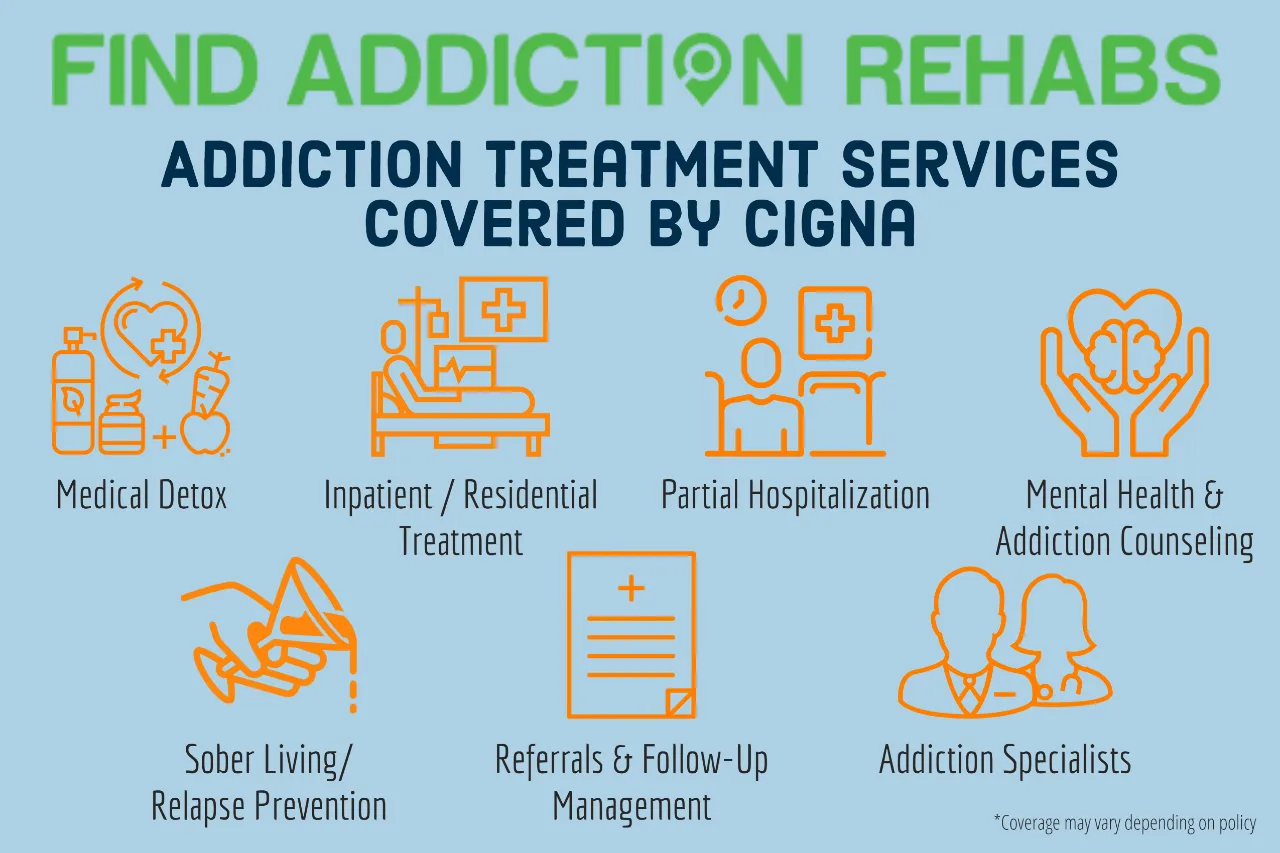Drug And Alcohol Rehab Centers That Take Cigna Insurance
Table of Contents
- Drug And Alcohol Rehab Centers That Take Cigna Insurance
- Does Cigna Cover Mental Health & Substance Abuse Treatment?
- Alcohol and Drug Addiction Treatment Services Covered By Cigna
- How Do I Find What Doctors and Facilities are In-Network?
- How do I Know What Treatment Centers Cigna Will Cover?
- How Do I Know What My Cigna Insurance Will Cover?
- How Can I Pay For Costs Not Covered By My Insurance Plan?
- Purchasing Cigna Insurance for Rehab
- Detox and Rehab Programs Using Cigna Insurance: Get Started Now!
- Frequently Asked Questions on Cigna Drug Rehab and Alcohol Rehab Coverage
- Medically Reviewed By
For those who are struggling with a drug or alcohol addiction, it can be hard to make the decision to get the help they need, especially when they are concerned about the costs of rehab. Fortunately, Cigna rehab coverage can help make this process much less daunting.
If you are trying to find a rehab center or treatment program that accepts Cigna, the Find Addiction Rehabs team will help you every step of the way. Our website will help you find the right treatment facility for mental health and substance abuse rehabs that accept Cigna insurance.
We will also provide information on different types of Cigna’s insurance plans and policies, and the level of insurance coverage you may be able to receive with Cigna substance abuse treatment services. If you can’t pay for treatment or if you lost your job, we have solutions for that here too.
Keep reading to find out more regarding alcohol and drug rehab facilities that accept Cigna, and plan your path to recovery now! Remember you can call us on our hotline or live chat with us 24/7 to get more specific answers if you need them.
Does Cigna Cover Mental Health & Substance Abuse Treatment?
Yes! It absolutely does. Under the Affordable Care Act (ACA), all health insurance providers are required to offer their clients the same level of coverage for alcohol and drug rehab services as they would receive for other medical or surgical conditions.
Cigna is a worldwide health service company that provides its clients with various insurance benefits to help them afford substance abuse and mental health treatment. Whether you are struggling with drug or alcohol abuse, Cigna’s health insurance plans make it easier and more affordable to seek treatment.
For those struggling with drug and alcohol addiction, this can be incredibly reassuring as they begin their search for drug rehab centers and mental health services. If you have a Cigna insurance plan, you will have access to a wide variety of healthcare services.
The amount that your Cigna health insurance plan covers will vary based on the type of policy and benefits you have, but many options are available for every stage of mental health and substance abuse treatment.
Alcohol and Drug Addiction Treatment Services Covered By Cigna
For those seeking rehabilitation for substance addiction and who are covered through Cigna, their insurance company will, in most cases, cover various types of alcohol and drug rehab treatment services.
While it will be important to check what services are covered under your health plan with your insurance carrier before making any final decisions, services that are generally covered by Cigna include:
Medical Detoxification
When an individual is going through withdrawal from alcohol or drug abuse, it is highly recommended that they go to a medical facility for detoxification. When detoxing from a substance, an individual can go through a withdrawal period that should not be treated at home because it’s possibly dangerous due to the side effects of withdrawal from a substance.
In a medical detox rehab facility, the individual is medically monitored by doctors, nurses, and a staff of licensed healthcare providers so that they can go through this process in a safe and healthy way.
Inpatient Treatment
Inpatient alcohol and drug rehabs can provide more intensive behavioral health services to those struggling with substance use disorders. These are best suited to those struggling with more severe addictions, or who have a co-occurring medical condition or mental illness that may complicate their treatment process.
Inpatient and residential drug and alcohol rehab treatment programs provide 24/7 care and support, meaning they may rack up higher out-of-pocket expenses. Fortunately, having private health insurance through Cigna can help significantly reduce these costs when receiving treatment through in-network providers.
Partial Hospitalization PHP
PHP or a Partial Hospitalization Program is a structured outpatient rehab program where the individual is not living in the facility but goes there for scheduled hours most days of the week. They benefit from the facilities services like doctors, psychologists, therapists, and groups.
Similar to PHP, recovering individuals may also wish to seek out an intensive outpatient program (IOP). These outpatient services can help those struggling with alcohol or drug addiction receive more intensive but still flexible care.
Many insurance companies will help cover the expenses of outpatient programs, so long as they are deemed necessary for the recovering individual.
Mental Health and Addiction Counseling
Mental Health Counselors help those who come to them with mental, mood, and emotional disorders. There are many in addiction that are dual diagnosis which means that they might have an addiction and a mental or mood disorder. Addiction and dual diagnosis patients are counseled differently.
Addiction counseling is centered primarily on addiction. Both kinds of counselors focus on thought patterns, emotions, and behavioral therapy. Regardless of the level of counseling needed, finding a provider or rehab that accepts Cigna insurance will remain a crucial factor.
Addiction Specialists
An addiction specialist is when a doctor or psychiatrist who declares addiction as one of their specialties. These medical professionals then become certified in addiction treatment. Addiction specialists are also able to diagnose patients and refer them to treatment facilities and other specialists if need be.
They truly have a vast knowledge of the addiction cycle and proper personalized treatment for their clients. Although rehabs that accept Cigna insurance don’t need to have such a specialist on staff, many times such a provider is available either on or off-site.
Referrals and Follow-up Management
After treatment, doctors from the treatment center might send a client to another doctor or facility for alternative care. That is when a referral, basically a note to another facility stating that the person is recommended for this service, might be required.
There is also often follow-up management where an individual might return to the treatment center for additional therapy and care. This is a great form of accountability for long-term sobriety.
Sober Living Homes
After leaving a rehab facility, it is recommended that those recovering from a substance use disorder should go to a sober living facility. These are also known as halfway homes or three-quarter-way houses. In these houses, individuals live with people that are all trying to do the same thing: maintain long-term sobriety.
Usually, there are meeting requirements, consistent drug testing, and curfews. These homes provide structure so that there is another level of care after treatment. It is a good way for the person to become more acclimated with living in the real world while still being held accountable by others.
How Do I Find What Doctors and Facilities are In-Network?
If you want to find out if your primary care provider, specialty doctors, pharmacies, and facilities are in-network or out of network you would simply go to Cigna’s website, choose the plan that you would choose, and then search the provider directory.
There is a search box if you want to search for specific doctors and rehab centers. Your search results will display services that are in-network according to the plan that you want to choose. The search also provides more details about enrolling in a plan.
Our services offer insurance verification over the phone for free. It is super fast and extremely easy! All you have to do is fill out one of the many forms across the website. You can communicate with us on our hotline or with our 24/7 live chat if you have any questions or need support in any way.
How do I Know What Treatment Centers Cigna Will Cover?
You can find out what centers Cigna covers within 5 minutes. All you have to do is call Find Addiction Rehabs and they will let you know what options are available to you with the plan that you have as well as what will be covered.
It can also be as easy as filling out a form online. Cigna’s coverage depends on your plan and the state that you live in. Preauthorization with Cigna will determine what they will cover medically when it comes to your treatment so make sure you are pre-authorized so you do not have to pay out-of-pocket costs that you could have prevented.
Be assured that in most cases, Cigna insurance has a variety of treatment centers that it does cover. Just don’t forget about your deductible because if it is not met you will have to complete the payment. There will also be copays and coinsurance costs. Staying in-network will help you save money because you will not be paying for the full cost of treatment.
Cigna has contracts within network treatment centers, and they are determined to cost less than those that are out of network. Enrolling in an individual or travel plan is suggested because there might be a treatment center that provides higher quality care out of network. There is a multitude of treatment centers and we will help you find the best treatment option available to you with your finances in mind. The cost of treatment will be far less than the cost of addiction.
Taking this step to find a drug and alcohol rehab that accepts Cigna insurance remains your best chance at minimizing your own expenses and ensuring treatment is covered as much as possible.
Will Cigna Insurance Cover Out-of-State Rehab?
Cigna does cover out-of-state rehab programs both in-network and out-of-network. For out-of-network services, your insurance policy must have out-of-state benefits for coverage.
Check with our expert team at Find Addiction Rehabs to make sure that the treatment facility and services they provide are covered now with a confidential call!
How Do I Know What My Cigna Insurance Will Cover?
Find Addiction Rehabs forms a reliable resource for finding what your insurance will cover. As we search together for rehab facilities you can feel relieved that you will know precisely what you will have to pay for.
We understand that finances can be a deciding factor in choosing a facility, but we will make sure to find the best possible treatment center for your lifestyle needs. We can review any information you give us about your plan so that we can communicate to you what will be covered. We are available 24/7 on our hotline and on live chat so we can estimate prices for you.
Once you choose a plan with Cigna, you will have an understanding of what your deductible is, and the percentages of your coinsurance after having paid the deductible. Knowing the coinsurance percentages will give you an idea of what your out-of-pocket costs will be. Whether you are looking for a rehab for yourself or a loved one, or even a couples rehab for you both, Find Addiction Rehabs can and will help!
How Can I Pay For Costs Not Covered By My Insurance Plan?
There are definitely options to cover what your insurance plan does not. If you do not have the financial means to cover the out-of-pocket costs, there are many treatment centers that will offer payment plans. Most treatment centers are “non-hardship,” meaning, they want to make sure that you get help and will work with you. Some treatment centers will provide scholarships to cover costs. There are personal or medical loans that you can apply for to pay for your medical expenses as well.
You can ask your family and friends for help. They want you to get better, and sometimes, if they have the means, they might help you cover the costs your insurance does not.
In today’s day and age, crowdfunding has also become a heartwarming and viable option. People will post on their social media and use different platforms so that they can earn donated funds from a large audience of people.
Purchasing Cigna Insurance for Rehab
There are a couple of ways that you can purchase Cigna Insurance. You can purchase it yourself privately through Cigna, you can purchase it through The Marketplace on Healthcare.gov, or you can be provided Cigna’s Health Insurance through your employer or school.
If you happen to be under 26, you may still be covered under your parent’s BCBC health coverage. In most cases, it is always recommended to purchase a Preferred Provider Organization or PPO insurance policy when seeking addiction treatment. The cost is definitely worth it.
Detox and Rehab Programs Using Cigna Insurance: Get Started Now!
To find a rehabilitation facility, you can find everything you need right here! By calling us, you can find a treatment center for your needs. You can also fill out our fast and free insurance verification form to find out what services are covered under your Cigna healthcare plan.
We will help you every step of the way, whether it be for addiction, physical, or mental treatment, we network with facilities across the nation, from coast to coast, so that you can be paired with the best possible rehab available to you.
Frequently Asked Questions on Cigna Drug Rehab and Alcohol Rehab Coverage
Do Medicaid services through Cigna cover substance abuse treatment?
While some Cigna partnerships with Medicaid do offer coverage for addiction rehab, it is not a foregone conclusion. When calling Find Addiction Rehabs, be sure to mention you have a Medicaid or Medicare policy affiliated with Cigna when asking for recommendations.
Is a Health Maintenance Organization or PPO better for addiction treatment?
While both HMO and PPO forms of Cigna insurance can provide effective levels of coverage for rehab, PPO plans generally have lower out-of-pocket costs and allow for their holders to visit a wider range of providers for treatment, both in and out of network.
* Disclaimer: Find Addiction Rehabs is not affiliated with or endorsed by Cigna. Details about Cigna’s coverage are intended for informational purposes only. The specific details of your plan may vary and the specific treatment services you require may or may not be covered. Please call our representatives today for more definitive details on your plan and options.
Deborah Tayloe is a freelance writer specializing in health and sciences. Deborah earned a B.S.Ed. in Secondary Education/English, accompanied by a Spanish minor. Her writing expertise allows her to craft engaging, impactful articles to help people be well.
In addition, she holds a fully accredited Certificate of Natural Medicine and is a certified Herbalist. Through her understanding of complementary medicine, Deborah helps medical professionals give people the information they need to embrace natural approaches to wellness.
When she’s not working, Deborah trains for 5K races and advocates for animal rights.








